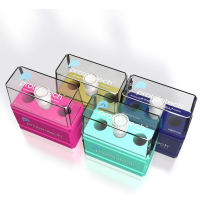BioID: A Screen for Protein‐Protein Interactions
互联网
- Abstract
- Table of Contents
- Materials
- Figures
- Literature Cited
Abstract
BioID is a unique method to screen for physiologically relevant protein interactions that occur in living cells. This technique harnesses a promiscuous biotin ligase to biotinylate proteins based on proximity. The ligase is fused to a protein of interest and expressed in cells, where it biotinylates proximal endogenous proteins. Because it is a rare protein modification in nature, biotinylation of these endogenous proteins by BioID fusion proteins enables their selective isolation and identification with standard biotin?affinity capture. Proteins identified by BioID are candidate interactors for the protein of interest. BioID can be applied to insoluble proteins, can identify weak and/or transient interactions, and is amenable to temporal regulation. Initially applied to mammalian cells, BioID has potential application in a variety of cell types from diverse species. Curr. Protoc. Protein Sci . 74:19.23.1?19.23.14. © 2013 by John Wiley & Sons, Inc.
Keywords: BioID; proximity?dependent labeling; protein?protein interaction; biotinylation
Table of Contents
- Introduction
- Strategic Planning
- Basic Protocol 1: Generation of Cells Expressing a BioID Fusion Protein
- Basic Protocol 2: BioID Pull‐Down to Identify Candidate Proteins
- Reagents and Solutions
- Commentary
- Figures
Materials
Basic Protocol 1: Generation of Cells Expressing a BioID Fusion Protein
Materials
Basic Protocol 2: BioID Pull‐Down to Identify Candidate Proteins
Materials
|
Figures
-
Figure 19.23.1 Outline of the BioID method. The following steps outline the BioID process. (1 ) Ligate bait cDNA and BioID in‐frame and in an appropriate expression vector. (2 ) Express BioID fusion protein in cells to (3 ) generate stably expressing cells. (4 ) Induce biotinylation with excess biotin prior to (5 ) cell lysis and protein denaturation. (6 ) Perform biotin‐affinity capture of biotinylated proteins. (7 ) Reserve 10% of the sample for streptavidin immunoblot analysis. Use the remainder of the sample for mass spectrometry either by (8A ) SDS‐PAGE separation with (8B ) identification of proteins in isolated bands or (9 ) analysis of peptides released by on‐bead digestion. View Image -
Figure 19.23.2 Analysis of cells stably expressing a BioID‐fusion protein. U2OS cells stably expressing BioID‐lamin A (LaA) were analyzed prior to large‐scale pull‐down experiments. (A ) By fluorescence microscopy it can be observed that all of the cells express similar levels of the myc‐tagged BioID‐LaA protein (red) targeted to the nuclear envelope. Following 24 hr incubation with excess biotin, the vast majority of the biotin signal, detected with streptavidin–Alexa Fluor 488 (green), co‐localizes with the fusion protein. DNA is detected with Hoechst dye (blue). Scale bar is 15 µm. (B ) Following SDS‐PAGE separation, the protein constituencies of BioID‐LaA and control U2OS cells were probed with both streptavidin‐HRP (top) and anti‐myc (bottom). As compared to the few naturally biotinylated proteins in the control sample, there is extensive biotinylation of endogenous proteins in the BioID‐LaA sample. View Image
Videos
Literature Cited
| Literature Cited | |
| Choi‐Rhee, E., Schulman, H., and Cronan, J.E. 2004. Promiscuous protein biotinylation by Escherichia coli biotin protein ligase. Protein Sci. 13:3043‐3050. | |
| Comartin, D., Gupta, G.D., Fussner, E., Coyaud, E., Hasegan, M., Archinti, M., Cheung, S.W., Pinchev, D., Lawo, S., Raught, B., Bazett‐Jones, D.P., Luders, J., and Pelletier, L. 2013. CEP120 and SPICE1 cooperate with CPAP in centriole elongation. Curr. Biol. 23:1360‐1366. | |
| Cronan, J.E. 2005. Targeted and proximity‐dependent promiscuous protein biotinylation by a mutant Escherichia coli biotin protein ligase. J. Nutr. Biochem. 16:416‐418. | |
| Donaldson, J.G. 2001. Immunofluorescence staining. Curr. Protoc. Cell Biol. 00:4.3.1‐4.3.6. | |
| Elion, E.A., Marina, P., and Yu, L. 2007. Constructing recombinant DNA molecules by PCR. Curr. Protoc. Mol. Biol. 78:3.17.1‐3.17.12. | |
| Kingston, R.E. 2003. Introduction of DNA into mammalian cells. Curr. Protoc. Mol. Biol. 9.0.1‐9.0.5. | |
| Kwon, K. and Beckett, D. 2000. Function of a conserved sequence motif in biotin holoenzyme synthetases. Protein Sci. 9:1530‐1539. | |
| Morriswood, B., Havlicek, K., Demmel, L., Yavuz, S., Sealey‐Cardona, M., Vidilaseris, K., Anrather, D., Kostan, J., Djinovic‐Carugo, K., Roux, K.J., and Warren, G. 2013. Novel bilobe components in Trypanosoma brucei identified using proximity‐dependent biotinylation. Eukaryot. Cell 12:356‐367. | |
| Roux, K.J., Kim, D.I., Raida, M., and Burke, B. 2012. A promiscuous biotin ligase fusion protein identifies proximal and interacting proteins in mammalian cells. J. Cell Biol. 196:801‐810. | |
| Van Itallie, C.M., Aponte, A., Tietgens, A.J., Gucek, M., Fredriksson, K., and Anderson, J.M. 2013. The N and C termini of ZO‐1 are surrounded by distinct proteins and functional protein networks. J. Biol. Chem. 288:13775‐13788. | |
| van Steensel, B. and Henikoff, S. 2000. Identification of in vivo DNA targets of chromatin proteins using tethered dam methyltransferase. Nat. Biotechnol. 18:424‐428. | |
| Internet Resources | |
| http://www.addgene.org/Kyle_Roux | |
| BioID plasmids containing epitope‐tagged humanized BirA (R118G) can be obtained from the nonprofit plasmid repository Addgene. | |
| http://www.sanfordresearch.org/researchcenters/childrenshealth/rouxlab/bioidresources/ | |
| Up‐to‐date information on BioID. |









